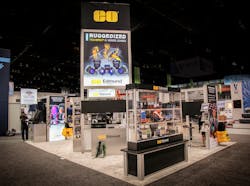VSD 25th Anniversary Q&A series: Edmund Optics on ever-advancing machine vision technology
Vision Systems Design celebrates its 25th anniversary in 2021. What are some of the most interesting and notable machine vision advancements you’ve seen since you entered the space?
The most notable advancement in machine vision that I’ve seen since I entered the space has been the complete transformation of interfaces between imaging systems and computers. Firewire, USB, and eventually GigE and other interfaces greatly reduced the barrier for entry and made systems much easier to use and less expensive.
This has allowed machine vision to become an industry itself rather than borrowing technology from adjacent industries like security, broadcasting, and photography. New interfaces allowed for easy increases in resolution and performance and have allowed optics and lighting to greatly expand because demand skyrocketed. Interfaces were the enabling technology that led to the surge in machine vision over the last few decades.
What sort of advancements are you most looking forward to, looking toward the future?
Advancements in data processing are now opening up brand new application spaces for machine vision. In the last decade, there have been a lot of advances in sensor technology and cost reductions. Innovations in interfaces made systems easier to connect to computers for processing, and now continued rapid increases in bandwidth are allowing imaging to go into all kinds of systems from all things autonomous to life sciences.
I’m excited because, if we can allow an autonomous vehicle to process information moving at 65 mph, just imagine what we will be able to do in five or ten years. Increases in processing throughput will change the world through everything from cancer diagnosis, to tailor-made pharmaceuticals, to shipping.
Do you have any notable Vision Systems Design-related stories to share from over the years?
Vision Systems Design has always been at the forefront of imaging technology and looking into the future, and we thank you for that. I’d like for a moment to look back and think of Andy Wilson, the founding editor of VSD. I was often interviewed by Andy about projects and was entertained by all the angles he used to get specific customer information out of me. He was trying to make his pieces more concrete for his readers, and he jokingly acted as if he was in despair when his different tactics didn’t work. He was always a good sport, and this was like an enjoyable game with him. While we weren’t always able to provide that information, I miss this game, Andy’s energy, and his humor.
What are you most excited about at your company right now?
I’m most excited about all the applications we’re involved in that are helping fight COVID-19, such as PCR tests for diagnosing the virus and antibody detection systems. Machine vision for logistics is also enabling the supply chain needed to allow us to shelter-in-place and minimize in-person contact. Even though we’re largely stuck at home, knowing that the company is doing something for the greater good helps keep us going.
I am thankful that our global design and manufacturing facilities remain functional and productive, allowing the company to continue supplying critical optics for these applications while many global supply chains are disrupted. Beyond COVID-19, I’m excited about all the other growing applications for imaging systems including autonomous systems and semiconductor inspection.
What is new and interesting in lens manufacturing today?
While it’s not a necessarily new concept, there have been significant advancements in strong environmental controls, such as ruggedization. This allows lens assemblies to be protected from shocks, vibrations, moisture, dust, and other harsh environments. This is especially important as imaging systems deploy into increasingly-demanding environments such as airborne vehicles and even low-Earth orbit. Customers expect that out-of-the-box imaging solutions will perform in these environments.
One other application of ruggedized lenses that many people may not think about is shipping calibrated imaging instruments. If you calibrate a precise imaging system but then put it on a truck and drop it on a factory floor, the calibration is likely lost due to the shocks and vibrations of shipping. Stability ruggedized lenses, however, can maintain performance throughout this process. Once the system arrives at its end-use location it will still be calibrated and ready to go.
What is your latest product and for what reason was it developed?
In the last few years, we’ve added a suite of ruggedized products to meet the increased demand in this area described earlier. Our Cr Series Fixed Focal Length Lenses are compact, stability ruggedized versions of our standard C series lenses designed to maintain pointing stability throughout shocks and vibrations. We also have Rugged Blue Series M12 Lenses for high vibration environments requiring even smaller imaging systems and HPr Series Fixed Focal Length Lenses that offer shock and vibration protection and high resolution for 2/3” and 1.1” sensors. We have developed in-house metrology for testing ruggedized lenses, allowing us to verify that they are meeting their specified shock rating.
In addition to ruggedizing lenses for shock and vibration, we also developed Ingress Protected HEO Series M12 Imaging Lenses that are sealed from moisture, humidity, dust, and other contaminants.
In which areas or applications do you see the most growth, in terms of machine vision/imaging?
Autonomous systems are certainly a growth area, and this does not just refer to systems like autonomous automobiles, but also automated agriculture equipment and industrial robotics. We are also seeing increasing demands in life sciences, consumer electronics, and metrology for manufacturing.
The current COVID-19 pandemic has certainly increased demand and awareness of medical applications. We have expanded our global manufacturing footprint to meet this growing demand for machine vision. For example, we expanded our assembly facility in Shenzhen, China to a 16,140 sq. ft location with a class 1000 clean room, class 100 laminar flow booths, and on-site testing equipment including MTF and interferometry. This new facility is key for the high-volume assembly of imaging lenses.
Is there a trend or product in the next few years that you see as "the next big thing?"
Minimizing size and weight while maintaining and even improving performance will be a driving focus over the next few years. However, pursuing these two goals simultaneously often fights with the physics of what is possible. Going back to autonomous systems, those customers need to reduce system weight as much as possible while ensuring that their devices can accurately gauge and safely navigate through their environment.
Developments in sensor technology, however, can help reduce element count, reducing system size and weight. Some of these advancements include placing light pipes in front of pixels, improving sensitivity and the speed at which they can run, and broadening dynamic range, which could let system integrators use one camera instead of two and get higher performance out of one lens.
Also, the push for more ruggedized systems is not slowing down. Further developments in ruggedization technology will be crucial for many new applications emerging over the next few years.


